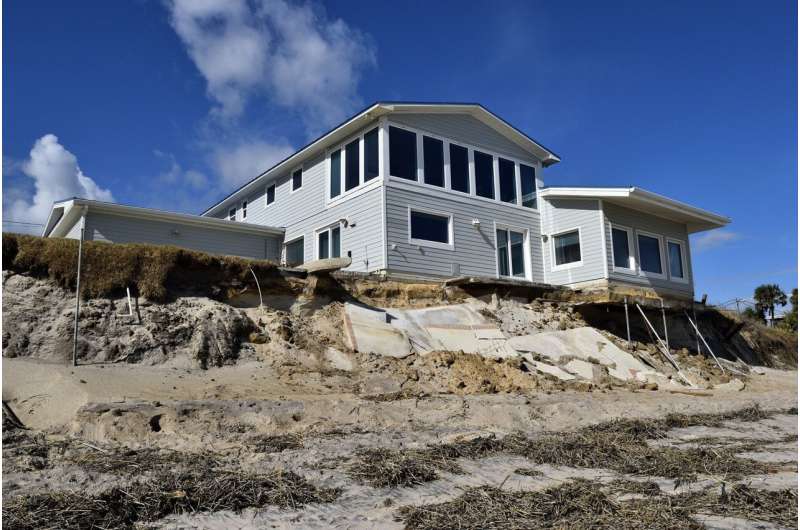
The National Oceanic and Atmospheric Administration predicts the 2024 Atlantic hurricane season will be more active than normal. This comes after an energetic 2023 season, which brought the fourth-most named storms since 1950.
A group of beach-loving environmental researchers wondered how a highly active hurricane season impacts beaches along the coast. When they looked at the impact of back-to-back hurricanes on beaches, their research found beaches with manmade fortifications—defensive structures, such as walls, towers and barriers—struggled to recover sand and vegetation after storms compared to natural beaches.
“Development along the coast has led to an increase in beautiful million-dollar homes and high-density apartments and condos,” said Matt McCarthy, a remote sensing research scientist at the Department of Energy’s Oak Ridge National Laboratory. “One of the biggest issues, however, is the loss of natural beach, either slowly through erosion from sea level rise or these pulse events from hurricanes and storms. This affects the stability of building foundations as well as how the ecosystem of the beach rebounds between storms and seasons.”
McCarthy, a Florida native, worked with colleagues at Bethune-Cookman University, Embry-Riddle Aeronautical University and the University of Tennessee to better understand how a natural beach recovers compared to a beach with a manmade seawall or other fortification. Their findings were published in Remote Sensing.
The study looked at the time period before, during and after two major hurricanes in 2022: Hurricane Ian and Hurricane Nicole. Ian, a Category 5 hurricane, formed in the Gulf of Mexico and hit the southwest corner of the Florida peninsula in late September. About six weeks later, Atlantic-formed Category 1 Hurricane Nicole hit the eastern coast of Florida. As devastating as these storms were to Floridians, the proximity of events gave McCarthy and his team a remarkable set of data.
“These two hurricanes happened so close to each other that we were able to get data between the two events,” McCarthy said. “We had data from before the hurricanes hit, in between the events, directly after, and then a year after.”
The researchers used satellite images and light detection and ranging data, or LIDAR, to measure elevation changes and vegetation coverage. Changes in elevation showed how much sand was depleted during the storm and how much sand returned throughout the following year. Measuring vegetation revealed how well the sand stays on the beach or how sand returns after a storm.
Saltwater surges into coastal cities corrode metal in building foundations. But saltwater also impacts beach plants in what McCarthy calls a “heart attack” situation.
“Many beach plants are already stressed by higher salinity levels from ever-rising seas,” he said. “A surge of saltwater can send the plant into a sudden stress situation that can kill it.”
Manmade fortifications have been constructed to secure building foundations along the coast and protect against seawater surges. The authors found these methods actually cause the beach to lose more vegetation during a storm and lack the ability to fully rebound after a storm. Sand erosion and restoration suffered as well, leaving fortified beaches less able to return to pre-storm levels.
Coastal areas face a tough reality as climate change continues to drive extreme weather events. The beach ecosystem is designed to ebb and flow with the weather, but human interference is negatively impacting the ability of the beach to replenish sand and vegetation. The people-versus-nature debate may be a cause of concern for national security.
“Climate security is a matter of national security,” McCarthy said. “This study indicates that preventing nature from replenishing after storms can degrade infrastructure and military bases located near coasts.”
“Back-to-back hurricanes can happen,” he said. “We can expect to see this continue in the future, especially in an active hurricane year like 2024 is predicted to be.”
More information:
Kelly M. San Antonio et al, Data-Driven Assessment of the Impact of Hurricanes Ian and Nicole: Natural and Armored Dunes in the Aftermath of Hurricanes on Florida’s Central East Coast, Remote Sensing (2024). DOI: 10.3390/rs16091557
Provided by
Oak Ridge National Laboratory
After hurricanes, beach erosion and recovery differs between natural beaches and those with fortifications (2024, August 13)
retrieved 14 August 2024
from https://phys.org/news/2024-08-hurricanes-beach-erosion-recovery-differs.html
part may be reproduced without the written permission. The content is provided for information purposes only.